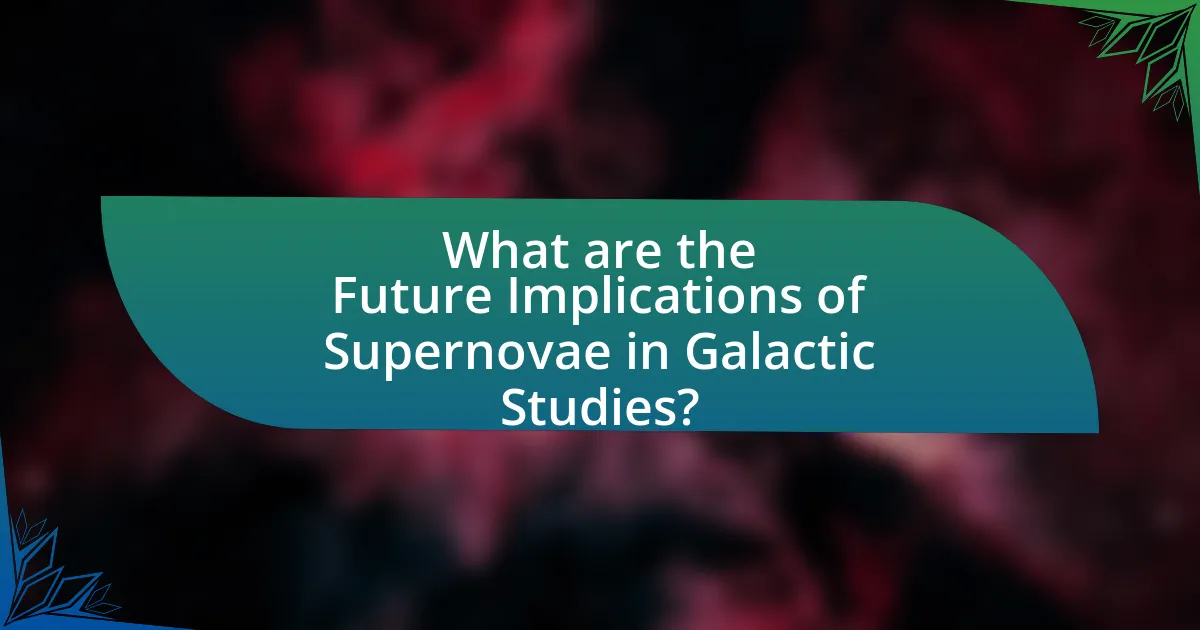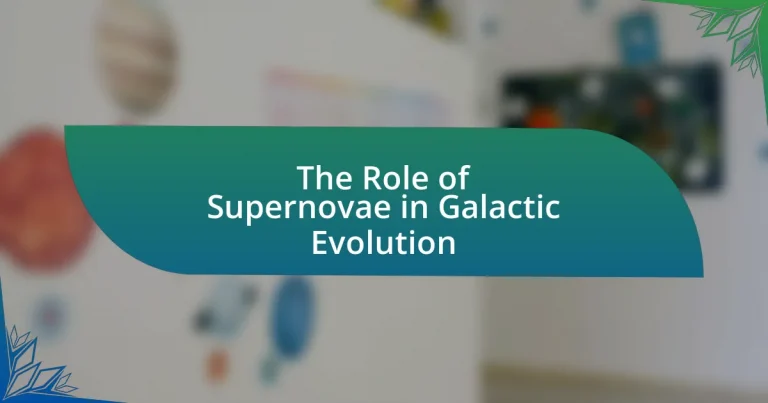Supernovae are explosive events marking the end of a star’s life cycle, playing a vital role in galactic evolution by enriching the interstellar medium with heavy elements essential for new star and planet formation. This article explores the mechanisms behind supernovae, including core-collapse and thermonuclear explosions, and categorizes them into Type I and Type II. It discusses their significance in chemical enrichment, star formation, and the dynamics of galaxies, highlighting how supernovae influence the lifecycle and morphology of galaxies. Additionally, the article examines observational data and future research directions that enhance our understanding of supernovae and their impact on cosmic events.

What are Supernovae and Their Significance in Galactic Evolution?
Supernovae are explosive events that occur at the end of a star’s life cycle, resulting in the ejection of the star’s outer layers and the release of an immense amount of energy. These phenomena play a crucial role in galactic evolution by enriching the interstellar medium with heavy elements, which are essential for the formation of new stars and planets. For instance, supernovae are responsible for dispersing elements like carbon, oxygen, and iron, which are fundamental to life and the structure of galaxies. Additionally, the shock waves generated by supernovae can trigger the collapse of nearby gas clouds, leading to the birth of new stars. This process contributes to the dynamic cycle of star formation and death within galaxies, influencing their structure and evolution over time.
How do Supernovae occur?
Supernovae occur through two primary mechanisms: the core-collapse of massive stars and the thermonuclear explosion of white dwarfs. In the core-collapse scenario, a massive star exhausts its nuclear fuel, leading to gravitational collapse, which results in a violent explosion. This process is supported by the fact that stars with masses greater than approximately eight times that of the Sun undergo this collapse, creating a supernova. In the thermonuclear explosion scenario, a white dwarf in a binary system accumulates matter from a companion star, eventually reaching a critical mass that triggers a runaway nuclear reaction, resulting in a supernova. This mechanism is evidenced by the consistent brightness and characteristics of Type Ia supernovae, which are used as standard candles in cosmology.
What are the different types of supernovae?
There are two primary types of supernovae: Type I and Type II. Type I supernovae occur in binary systems where one star is a white dwarf that accumulates matter from its companion until it reaches a critical mass, leading to a thermonuclear explosion. Type II supernovae result from the gravitational collapse of massive stars (greater than eight solar masses) at the end of their life cycle, resulting in a core collapse and subsequent explosion. The classification is supported by observational data, such as the light curves and spectra of these events, which reveal distinct characteristics associated with each type.
What processes lead to the explosion of a star?
The explosion of a star, known as a supernova, is primarily driven by the processes of nuclear fusion and gravitational collapse. In massive stars, nuclear fusion occurs in the core, converting hydrogen into helium and subsequently heavier elements until iron is formed. Once iron accumulates, fusion ceases to produce energy, leading to a loss of outward pressure. This imbalance causes the core to collapse under its own gravity, resulting in a catastrophic explosion that ejects the outer layers of the star into space. This process is supported by observations of supernova remnants, which show the distribution of elements produced during the explosion, confirming the role of nuclear fusion and gravitational collapse in stellar explosions.
Why are Supernovae important for galaxies?
Supernovae are important for galaxies because they play a crucial role in the chemical enrichment and energy dynamics of the interstellar medium. When a star explodes as a supernova, it disperses heavy elements, such as carbon, oxygen, and iron, into space, which are essential for the formation of new stars and planets. This process contributes to the overall evolution of galaxies by facilitating the recycling of materials necessary for star formation. Additionally, supernovae release vast amounts of energy, influencing the dynamics of gas clouds and triggering new star formation in nearby regions. Studies have shown that supernovae can initiate star formation in molecular clouds, thereby impacting the rate of star formation in galaxies.
How do Supernovae contribute to the chemical enrichment of galaxies?
Supernovae contribute to the chemical enrichment of galaxies by dispersing heavy elements into the interstellar medium during their explosive death. When a massive star undergoes a supernova, it ejects materials such as carbon, oxygen, and iron, which are synthesized in the star’s core through nuclear fusion. This ejected material enriches the surrounding gas and dust, providing the essential building blocks for new stars and planets. Studies show that supernovae are responsible for producing approximately 90% of the iron in the universe, significantly influencing the chemical composition of subsequent generations of stars and the overall evolution of galaxies.
What role do Supernovae play in star formation?
Supernovae play a crucial role in star formation by triggering the collapse of nearby molecular clouds. The explosive energy released during a supernova can compress surrounding gas and dust, leading to increased density in these clouds. This compression initiates the gravitational collapse necessary for new stars to form. Studies have shown that supernovae can enhance star formation rates in their vicinity by up to a factor of ten, as evidenced by observations of star-forming regions in galaxies like the Milky Way.
What are the observable effects of Supernovae on galactic structures?
Supernovae have significant observable effects on galactic structures, including the dispersal of heavy elements, the creation of shock waves, and the triggering of star formation. The explosion of a supernova ejects materials into the interstellar medium, enriching it with elements like carbon, oxygen, and iron, which are crucial for the formation of new stars and planets. Additionally, the shock waves generated by supernovae can compress nearby gas clouds, leading to increased density and the potential for new star formation. Observations from the Hubble Space Telescope have shown that regions surrounding supernova remnants often exhibit enhanced star formation activity, confirming the role of supernovae in shaping the evolution of galaxies.
How do Supernovae influence the interstellar medium?
Supernovae influence the interstellar medium by ejecting vast amounts of energy and material into space, which enriches the medium with heavy elements and drives shock waves that trigger star formation. The explosion of a supernova can release energy equivalent to that of billions of suns, dispersing elements like carbon, oxygen, and iron into the interstellar medium, which are essential for the formation of new stars and planets. Additionally, the shock waves generated by the explosion compress surrounding gas and dust, leading to the formation of new molecular clouds, as evidenced by observations of supernova remnants such as the Crab Nebula, where new star formation has been detected in the surrounding material.
What impact do Supernovae have on nearby stars and planetary systems?
Supernovae significantly impact nearby stars and planetary systems by releasing intense radiation and shock waves that can alter their environments. The explosion generates high-energy particles and radiation, which can strip away atmospheres from surrounding planets and disrupt the formation of new stars. For instance, studies indicate that supernovae can trigger star formation in nearby molecular clouds by compressing gas and dust, leading to the birth of new stars. Additionally, the heavy elements produced during a supernova enrich the interstellar medium, contributing to the chemical diversity necessary for planet formation. This process has been observed in regions such as the Orion Nebula, where supernova remnants influence the surrounding stellar nursery.

How do Supernovae Drive Galactic Evolution?
Supernovae drive galactic evolution by dispersing heavy elements into the interstellar medium, which enriches the gas and dust that form new stars and planets. When a massive star explodes as a supernova, it releases a vast amount of energy and material, including elements like carbon, oxygen, and iron, which are crucial for the formation of subsequent generations of stars. This process contributes to the chemical evolution of galaxies, as evidenced by observations showing that regions with recent supernova activity have higher metallicity, indicating a greater abundance of heavy elements. Additionally, the shock waves generated by supernovae can trigger the collapse of nearby gas clouds, leading to new star formation, thereby influencing the structure and dynamics of galaxies over time.
What mechanisms link Supernovae to the evolution of galaxies?
Supernovae contribute to the evolution of galaxies through several mechanisms, including the dispersal of heavy elements, the regulation of star formation, and the influence on galactic dynamics. When a massive star explodes as a supernova, it ejects a significant amount of material enriched with heavy elements into the interstellar medium, which can then be incorporated into new stars and planets, enriching the chemical composition of the galaxy. This process is crucial for the formation of terrestrial planets and the development of life.
Additionally, the energy released during a supernova can trigger shock waves that compress nearby gas clouds, leading to the formation of new stars. This feedback mechanism regulates star formation rates within galaxies, influencing their overall structure and evolution. Furthermore, supernovae can impact the dynamics of galaxies by injecting energy into the interstellar medium, driving galactic winds, and affecting the motion of gas and dust, which can alter the gravitational balance and morphology of the galaxy.
These mechanisms are supported by observations of supernova remnants and their effects on surrounding gas clouds, as well as simulations that demonstrate the role of supernovae in galactic evolution. For instance, studies have shown that regions with recent supernova activity exhibit increased star formation rates, highlighting their significant role in shaping the lifecycle of galaxies.
How do Supernovae affect the dynamics of galaxy formation?
Supernovae significantly influence the dynamics of galaxy formation by injecting energy and heavy elements into the interstellar medium. This explosive event creates shock waves that can trigger the collapse of nearby gas clouds, leading to new star formation. Additionally, the ejected materials enrich the surrounding gas with metals, which are crucial for the formation of terrestrial planets and complex life. Studies show that supernova feedback regulates star formation rates, preventing excessive star formation that could destabilize the galaxy. For instance, simulations indicate that supernova-driven outflows can remove gas from galaxies, affecting their growth and evolution over time.
What is the relationship between Supernovae and galaxy morphology?
Supernovae significantly influence galaxy morphology by contributing to the chemical enrichment and dynamical evolution of galaxies. The explosive death of massive stars releases energy and heavy elements into the interstellar medium, which can trigger star formation and alter the structure of the galaxy. For instance, studies have shown that supernovae can create shock waves that compress nearby gas, leading to the formation of new stars, thereby affecting the overall shape and density distribution of the galaxy. Additionally, the energy released can drive galactic winds, impacting the galaxy’s ability to retain gas and thus influencing its morphological classification, such as whether it remains a spiral or evolves into an elliptical galaxy.
How do Supernovae influence the lifecycle of galaxies?
Supernovae significantly influence the lifecycle of galaxies by enriching the interstellar medium with heavy elements and triggering star formation. When a massive star explodes as a supernova, it disperses elements like carbon, oxygen, and iron into the surrounding space, contributing to the chemical evolution of the galaxy. This process enhances the material available for new stars, leading to the formation of subsequent generations of stars that are richer in heavy elements compared to their predecessors. Studies, such as those by Woosley and Weaver (1995), demonstrate that supernovae play a crucial role in the nucleosynthesis of elements and the dynamics of galactic evolution, ultimately shaping the structure and composition of galaxies over time.
What is the role of Supernovae in the transition from starburst to quiescent galaxies?
Supernovae play a critical role in the transition from starburst to quiescent galaxies by regulating star formation and enriching the interstellar medium with heavy elements. During a starburst phase, galaxies experience rapid star formation, leading to the eventual explosion of massive stars as supernovae. These explosions inject energy and momentum into the surrounding gas, driving outflows that can suppress further star formation by removing gas needed for new stars. Additionally, supernovae contribute to the chemical enrichment of the galaxy, altering the composition of the interstellar medium and influencing subsequent star formation processes. Studies have shown that the feedback mechanisms from supernovae are essential in transitioning galaxies from a high star formation rate to a more stable, quiescent state, as evidenced by observations of gas depletion and changes in star formation rates in nearby galaxies.
How do Supernovae contribute to the feedback processes in galaxies?
Supernovae contribute to the feedback processes in galaxies by ejecting vast amounts of energy and material into the interstellar medium, which influences star formation and the chemical enrichment of galaxies. When a star explodes as a supernova, it releases energy equivalent to billions of suns, creating shock waves that can compress nearby gas clouds, triggering new star formation. Additionally, the heavy elements produced during the supernova event enrich the surrounding gas, contributing to the next generation of stars and planetary systems. This cycle of energy release and material recycling is crucial for regulating star formation rates and the overall evolution of galaxies.
What evidence supports the role of Supernovae in galactic evolution?
Supernovae play a crucial role in galactic evolution by enriching the interstellar medium with heavy elements and influencing star formation rates. Observations show that supernovae contribute to the chemical evolution of galaxies, as they produce elements like carbon, oxygen, and iron, which are essential for forming new stars and planets. For instance, studies of the Milky Way’s chemical composition reveal that the abundance of heavy elements correlates with supernova activity, indicating that these explosive events are significant sources of galactic metal enrichment. Additionally, simulations of galaxy formation demonstrate that supernova feedback regulates star formation by injecting energy into the surrounding gas, thereby preventing excessive star formation and promoting a balanced galactic ecosystem.
What observational data have been collected regarding Supernovae and galaxies?
Observational data collected regarding supernovae and galaxies include light curves, spectra, and host galaxy characteristics. Light curves provide information on the brightness and decline rates of supernovae, which help classify them into types such as Type Ia and Type II. Spectra reveal the chemical composition and velocity of ejected materials, indicating the explosion mechanisms and progenitor stars. Additionally, studies of host galaxies, including their morphology, star formation rates, and metallicity, offer insights into the environments where supernovae occur. For instance, research has shown that Type Ia supernovae are often found in older, metal-rich galaxies, while core-collapse supernovae are more common in star-forming regions of younger galaxies. These data collectively enhance our understanding of the role supernovae play in galactic evolution and chemical enrichment of the universe.
How do simulations help us understand the impact of Supernovae on galactic evolution?
Simulations help us understand the impact of supernovae on galactic evolution by modeling the complex interactions between supernova explosions and their surrounding environments. These simulations reveal how supernovae contribute to the chemical enrichment of galaxies, influence star formation rates, and drive galactic winds. For instance, research has shown that supernovae can inject energy and momentum into the interstellar medium, leading to the formation of new stars and altering the dynamics of gas within galaxies. Additionally, simulations provide insights into the feedback mechanisms that regulate galaxy growth and evolution, demonstrating that supernovae play a crucial role in shaping the structure and composition of galaxies over cosmic time.

What are the Future Implications of Supernovae in Galactic Studies?
The future implications of supernovae in galactic studies include their role in enriching the interstellar medium with heavy elements and influencing star formation rates. Supernovae eject significant amounts of elements like carbon, oxygen, and iron into space, which are crucial for the formation of new stars and planets. Research indicates that supernovae can trigger the collapse of nearby gas clouds, leading to new star formation, as evidenced by studies showing correlations between supernova remnants and regions of active star formation. Additionally, supernovae contribute to the dynamics of galaxies by injecting energy and momentum into the interstellar medium, affecting galactic structure and evolution over time. This understanding is supported by observations from telescopes like Hubble and data from simulations that model the impact of supernovae on galactic environments.
How can studying Supernovae enhance our understanding of the universe?
Studying supernovae enhances our understanding of the universe by providing insights into stellar evolution, nucleosynthesis, and cosmic expansion. Supernovae are critical endpoints of massive stars, and their explosive deaths contribute to the chemical enrichment of galaxies, dispersing heavy elements necessary for planet formation. For example, the Type Ia supernovae serve as standard candles for measuring cosmic distances, allowing astronomers to determine the rate of the universe’s expansion, which has implications for dark energy research. Additionally, the remnants of supernovae, such as neutron stars and black holes, offer clues about the fundamental physics governing extreme environments. Thus, supernovae play a pivotal role in shaping our comprehension of cosmic structures and the overall dynamics of the universe.
What future research directions are being explored regarding Supernovae?
Future research directions regarding supernovae include studying their role in cosmic chemical enrichment, understanding the mechanisms behind different types of supernovae, and investigating their impact on star formation and galactic dynamics. Researchers aim to utilize advanced observational techniques, such as gravitational wave detection and multi-messenger astronomy, to gain insights into the progenitor stars and the explosion mechanisms. For instance, the upcoming James Webb Space Telescope will enhance the ability to observe supernovae in distant galaxies, providing data on their frequency and effects on galactic evolution. Additionally, simulations and modeling efforts are being refined to better predict the outcomes of supernova explosions and their influence on surrounding interstellar medium.
How might advancements in technology improve our observations of Supernovae?
Advancements in technology can significantly enhance our observations of supernovae by providing more sensitive instruments and improved data analysis techniques. For instance, the development of space-based telescopes, such as the James Webb Space Telescope, allows astronomers to observe supernovae in various wavelengths, including infrared, which can reveal details obscured by dust. Additionally, advancements in machine learning algorithms enable the rapid analysis of vast amounts of astronomical data, facilitating the identification and classification of supernovae events with greater accuracy. These technological improvements lead to a deeper understanding of the mechanisms behind supernovae and their impact on galactic evolution, as evidenced by the increased number of detected supernovae and the detailed light curves produced by modern observational techniques.
What practical insights can we gain from the study of Supernovae in galactic evolution?
The study of supernovae provides practical insights into the processes of galactic evolution, particularly in understanding the formation and distribution of elements in the universe. Supernovae are responsible for dispersing heavy elements, such as carbon, oxygen, and iron, into the interstellar medium, which contributes to the chemical enrichment of galaxies. This enrichment is crucial for the formation of new stars and planetary systems, as evidenced by the observation that regions with higher concentrations of supernova remnants correlate with areas of active star formation. Additionally, supernovae influence the dynamics of galaxies by driving shock waves that can trigger star formation or regulate the interstellar gas density, thereby shaping the overall structure and evolution of galaxies over time.
How can knowledge of Supernovae inform our understanding of cosmic events?
Knowledge of supernovae enhances our understanding of cosmic events by providing insights into the life cycles of stars and the chemical enrichment of the universe. Supernovae are critical endpoints in the evolution of massive stars, leading to the dispersal of heavy elements into the interstellar medium, which contributes to the formation of new stars and planets. For instance, the Type II supernova SN 1987A, observed in 1987, allowed astronomers to study the explosion dynamics and the resulting nucleosynthesis, revealing that supernovae are responsible for producing elements like iron and nickel. This process is essential for understanding the distribution of elements in galaxies and the overall chemical evolution of the cosmos.
What lessons can be learned from Supernovae for future astronomical research?
Supernovae provide critical insights for future astronomical research, particularly in understanding stellar evolution and the chemical enrichment of galaxies. They serve as key indicators of the life cycles of massive stars, allowing researchers to refine models of stellar evolution and the processes leading to supernova explosions. For instance, the study of Type Ia supernovae has been instrumental in measuring cosmic distances and understanding dark energy, as evidenced by the discovery that the universe’s expansion is accelerating. Additionally, supernovae contribute to the distribution of heavy elements in the interstellar medium, which is essential for the formation of new stars and planets. This chemical feedback mechanism is crucial for models of galactic evolution, as it influences star formation rates and the overall dynamics of galaxies. Thus, the lessons learned from supernovae not only enhance our understanding of individual stellar processes but also inform broader theories regarding the evolution and structure of the universe.




